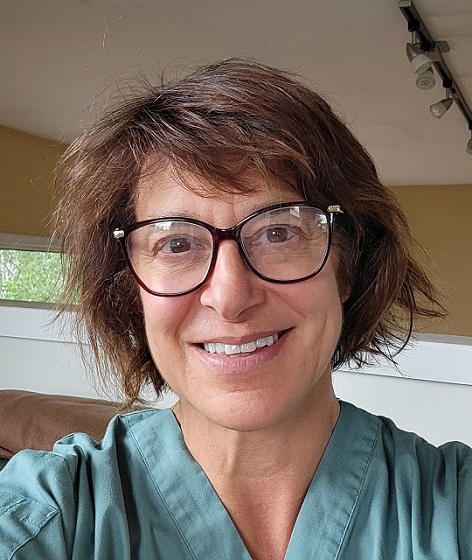Addictions
“Safer supply” reminiscent of the OxyContin crisis, warns addiction physician

Dr. Lori Regenstreif, MD, MSc, CCFP (AM), FCFP, MScCH (AMH), CISAM, has been working as an addiction medicine physician in inner city Hamilton, Ontario, since 2004. She co-founded the Shelter Health Network in 2005 and the Hamilton Clinic’s opioid treatment clinic in 2010, and helped found the St. Joseph’s Hospital Rapid Access Addiction Medicine (RAAM) clinic.
|
[This article is part of Break The Needle’s “Experts Speak Up” series, which documents healthcare professionals’ experiences with Canada’s “safer supply” programs] By: Liam Hunt
Dr. Lori Regenstreif, an addiction physician with decades of experience on the frontlines of Canada’s opioid crisis, is sounding the alarm about the country’s rapidly expanding “safer supply” programs.
While proponents of safe supply contend that providing drug users with free tablets of hydromorphone – a pharmaceutical opioid roughly as potent as heroin – can mitigate harms, Dr. Regenstreif expresses grave concern that these programs may inadvertently perpetuate new addictions and entrench existing opioid use.
She sees ominous similarities between safer supply and the OxyContin crisis of the late 1990s, when the widespread overprescribing of opioids flooded North American communities with narcotics, sparking an addiction crisis that continues to this day. Having witnessed the devastating consequences of OxyContin in the late 1990s, she believes that low-quality and misleading research is once again encouraging dangerous overprescribing practices.
Flashbacks to the OxyContin Crisis
Soon after Dr. Regenstreif received her medical license in Canada, harm reduction became the primary framework guiding her practice in inner-city Vancouver. This period coincided with Health Canada’s 1996 regulatory approval of oxycodone (brand name: OxyContin) based on trials, sponsored by Purdue Pharma, that failed to assess the serious risks of misuse or addiction.
Dr. Regenstreif subsequently witnessed highly addictive prescription opioids flood North American streets while Purdue and its distributors reaped record profits at the expense of vulnerable communities. “That was really peaking in the late 90s as I was coming into practice,” she recounted during an extended interview with Break The Needle. “I was being pressured to prescribe it as well.”
Oxycodone addiction led to the deaths of tens of thousands of individuals in the United States and Canada. As a result, Purdue Pharma faced criminal penalties, fines, and civil settlements amounting to 8.5 billion USD, ultimately leading to the company’s bankruptcy in 2019.
During the OxyContin crisis, patients would regularly procure large amounts of pharmaceutical opioids for resale on the black market – a process known as “diversion.” Dr. Regenstreif has seen alarming indications that safer supply hydromorphone is being diverted at similarly high levels, and estimated that, out of her patient pool, “15 to 20 out of maybe 40 people who have to go to a pharmacy frequently” have reported witnessing diversion.
Between one to two thirds of her new patients have told her that they are accessing diverted hydromorphone tablets – in many cases, the tablets almost certainly originate from safer supply.
Injecting crushed hydromorphone tablets pose severe health risks, including endocarditis and spinal abscesses. “I’ve seen people become quadriplegic and paraplegic because the infection invaded their spinal cord and damaged their nervous system,” said Dr. Regenstreif. While infections can be mitigated by reducing the number of times drug users inject drugs into their bodies, she says that safer supply programs do not discourage or reduce injections.
She further noted, “I’ve seen a teenager in [the] hospital getting their second heart valve replacement because they continue to inject after the first one.” The pill that nearly stopped the patient’s heart was one of the tens of thousands of hydromorphone tablets handed out daily via Canadian safe supply programs.
Her experiences are consistent with preliminary data from a scientific paper published by JAMA Internal Medicine in January, which found that safe supply distribution in British Columbia is associated with a “substantial” increase in opioid-related hospitalizations, rising by 63% over the first two years of program implementation — all without reducing deaths by a statistically significant margin.
While Dr. Regenstreif has worked in a variety of settings, from Ontario’s youth correctional system to Indigenous healing facilities in the Northwest Territories, her experiences in Australia, where she worked during a sabbatical year from 2013 to 2014, were particularly educational.
Australia has far fewer opioid-related deaths than Canada – in 2021, opioid mortality rates were 3.8 per 100,000 in Australia and 21 per 100,000 in Canada (a difference of over 500%). Dr. Regenstreif credited this difference to Australia’s comparatively controlled opioid landscape, where access to pharmaceutical narcotics is tightly regulated.
“Heroin had been a long-standing street opioid. It was really the only opioid you tended to see, because the only other ones people could get a prescription for were over-the-counter, low-potency codeine tablets,” she said. To this day, opioid prescriptions in Australia require special approval for repeat supplies, preventing stockpiling and street diversion.
No real evidence supports “safer supply”
Critics and whistleblowers have argued that Canadian safe supply programs, which have received over $100 million in federal funding through Health Canada’s Substance Use and Addictions Program (SUAP), were initiated without adhering to the rigorous evidentiary standards typically required to classify medication as “safe.”
Dr. Regenstreif shares these concerns and says that no credible studies show that safer supply saves lives, and that little effort is invested into exploring its possible risks and unintended consequences – such as increased addiction, hospitalization, overdose and illicit diversion to youth and vulnerable individuals.
Most studies which support the experiment simply interview recipients of safer supply and then present their answers as objective evidence of success. Dr. Regenstreif criticized these qualitative studies as methodologically flawed “customer satisfaction surveys,” as they are “very selective” and rely on small, bias-prone samples.
“If you have 400 people in a program, and you get feedback from 12, and 90% of those 12 said X, that’s not [adequate] data,” said Dr. Regenstreif, criticizing the lack of follow-up often shown safer supply researchers. “Nobody seems to track down the […] people who were not included. Did they get kicked out of the program? [Did they engage in] diversion? Did they die? We’re not hearing about that. It doesn’t make any sense in an empirical scientific universe.”
Safe supply advocates typically argue that opioids themselves are not problematic, but rather their unregulated and illicit supply, as this allows for contaminants and unpredictable dosing. However, studies have found that opioid-related deaths rise when narcotics, legal or not, are more widely available.
Dr. Regensteif is calling upon harm reduction researchers to build a more robust evidence base before calling for the expansion of safer supply. That includes more methodologically rigorous and transparent quantitative research to evaluate the full impact of Canada’s harm reduction strategies. Forgoing this evidence or adequate risk-prevention measures could lead to consequences as catastrophic as those resulting from Purdue’s deceptive marketing of OxyContin, she said.
Subscribe to our newsletter to get our latest news and analysis – or donate to our investigative journalism fund.
Critics propose solutions despite bullying
Dr. Regenstreif has faced pressure and exclusion for speaking out against safe supply. She estimates that while only a quarter of her local colleagues shared her doubts a few years ago, “now I would say more than half” harbor the same concerns. However, many are reluctant to voice their reservations publicly, fearing professional or social repercussions. “People who don’t want to speak out don’t want to be labeled as right-wing […] they don’t want to be labeled as conservative.”
While she acknowledges that safe supply may play a limited role for a small subset of patients, she believes it has been oversold as a panacea without adequate safeguards or due evaluation. “It doesn’t seem as if policymakers are listening to the people on the ground who have experience in doing this,” she said.
She contends that the solution to Canada’s addiction crisis lies in a more holistic, recovery-oriented approach that includes all four pillars of addiction: harm reduction, prevention, treatment, and enforcement. Her vision includes a national network of publicly-funded, rapid-access addiction medicine clinics with integrated counseling and wraparound services.
Additionally, Dr. Regenstreif stresses the importance of building upon established opioid agonist treatments (OAT), like methadone and buprenorphine, rather than solely relying on novel approaches whose social and medical risks are not yet fully understood.
At the core of Dr. Regenstreif’s advocacy lies a profound dedication to her patients and to the science of addiction medicine. “I like to think I kind of am fear-mongering with my patients, [by] trying to make them afraid of not getting better,” she explains. “I don’t want them to end up in the hospital and not come back out. I don’t want them to end up dead.”
[This article has been co-published with The Bureau, a Canadian media outlet that tackles corruption and foreign influence campaigns through investigative journalism. Subscribe to their work to get the latest updates on how organized crime influences the Canadian drug trade.]
Addictions
Manitoba Is Doubling Down On A Failed Drug Policy

From the Frontier Centre for Public Policy
Manitoba is choosing to expand the same drug policy model that other provinces are abandoning, policies that normalize addiction while sidelining treatment, recovery, and public safety.
The New Democrat premier of British Columbia, David Eby, stood before reporters last spring and called his government’s decision to permit public drug use in certain spaces a failure.
The policy was part of the broader “harm reduction” strategy meant to address overdose deaths. Instead, it had stirred public anger, increased street disorder and had helped neither users nor the communities that host them. “We do not accept street disorder that makes communities feel unsafe,” Eby said. The province scrapped the plan.
In Alberta, the Conservative government began shutting down safer-supply prescribing due to concerns about drug diversion and misuse. The belief that more opioids can resolve the opioid crisis is losing credibility.
Ontario Progressive Conservatives are moving away from harm reduction by shutting down supervised consumption sites near schools and limiting safer-supply prescribing. Federal funding for programs is decreasing, and the province is shifting its focus to treatment models, even though not all sites are yet closed.
Yet amid these non-partisan reversals, Manitoba’s government has announced its intention to open a supervised drug-use site in Winnipeg. Premier Wab Kinew said, “We have too many Manitobans dying from overdose.” True. But it does not follow that repeating failed approaches will yield different results.
Reversing these failed policies is not a rejection of compassion. It is a recognition that good intentions do not produce good outcomes. Vancouver and Toronto have hosted supervised drug-use sites for years. The death toll keeps rising. Drug deaths in British Columbia topped 2,500 in 2023, even with the most expansive harm reduction infrastructure in the country. A peer-reviewed study published this year found that hospitalizations from opioid poisoning rose after B.C.’s safer-supply policy was implemented. Emergency department visits increased by more than three cases per 100,000 population, with no corresponding drop in fatal overdoses.
And the problem persists day to day. Paramedics in B.C. responded to nearly 4,000 overdose calls in July 2024 alone. The monthly call volume has exceeded 3,000 almost every month this year. These are signs of crisis management without a path to recovery.
There are consequences beyond public health. These policies change the character of neighbourhoods. Businesses suffer. Residents feel unsafe. And most tragically, the person using drugs is offered little more than a cot, a nurse and a quiet signal to continue. Real help, like treatment, housing and purpose, remains out of reach.
Somewhere along the way, bureaucracies stopped asking what recovery looks like. They have settled for managing human decline. They call it compassion. But it is really surrender, wrapped in medical language.
Harm reduction had its time. It made sense when it first emerged, during the AIDS crisis, when dirty needles spread HIV. Back then, the goal was to stop a deadly virus. Today, that purpose has been lost.
When policy drifts into ideology, reality becomes an afterthought. Underneath today’s approach is the belief that drug use is inevitable, that people cannot change, that liberty means letting others fade away quietly. These ideas do not reflect science. They do not reflect hope. They reflect despair. They reflect a politics that prioritizes the appearance of compassion over effectiveness.
What Manitoba needs is treatment access that meets the scale of the problem. That means detox beds, recovery homes and long-term care focused on restoring lives. These may not generate the desired headlines, but they work. They are demanding. They are slow. And they offer respect to the person behind the addiction.
There are no shortcuts. No policy will undo decades of pain overnight. But a policy that keeps people stuck using is not mercy. It is maintenance with no way out.
A government that believes in its people should not copy failure.
Marco Navarro-Genie is vice-president of research at the Frontier Centre for Public Policy and co-author, with Barry Cooper, of Canada’s COVID: The Story of a Pandemic Moral Panic (2023).
Addictions
The Death We Manage, the Life We Forget

 Marco Navarro-Génie
Marco Navarro-Génie
Our culture has lost the plot about what it means to live.
Reading that Manitoba is bringing supervised consumption to Winnipeg got me thinking.
Walk through just about any major Canadian city, and you will see them. Figures bent forward at seemingly impossible angles, swaying in the characteristic “fentanyl fold,” suspended between consciousness and oblivion. They resemble the zombies of fiction: bodies that move through space without agency, awareness, or connection to the world around them. We think of zombies as the walking dead. Health workers and bureaucrats reverse their overdoses, send them back to the street, and call it saving lives.
At the same time, Canada offers medical assistance in dying to a woman who cited chemical sensitivities and the inability to find housing. It has been offered to veterans who asked for support and were met instead with an option for death. We fight to prevent one form of death while facilitating another. The contradiction is not accidental. It reveals something about the people involved and the funding behind it. That’s our culture. Us. It appears to me that our culture no longer knows what life is.
Ask any politician or program bureaucrat, and you will hear them explain, in the dry language of bureaucracy, that the twin approach to what they call harm reduction and medical assistance in dying (MAiD) rests on the shared premise of what they believe to be compassion. They think they respect autonomy, prevent suffering, and keep people alive when possible. It sounds humane. It is, in practice, incoherent. Bear with me for a moment.
The medical establishment administers naloxone to reverse overdoses in people who spend as many as twenty hours a day unconscious. They live without meaningful relationships or memories, with little capacity for choice. The technocrats and politicians call that saving lives. They also provide assisted death to people whose suffering comes primarily from poverty, isolation, or lack of housing. There was a time when these factors could, at least in theory, be addressed so that the terminal decision did not need to be made. Now they are accepted as grounds for ending life.
But why is one preference final and the other treated as an error to correct? That question reflects the deeper disorientation.
We saw the same thing during COVID. Elderly people in care homes were left without touch, family, or comfort for days. They often died in solitude, their dementia accelerated by isolation. And those conditions were inflicted upon them in the name of saving their lives. The “system” measured success in preventing infections, not in preserving connections. Je me souviens. Or we should.
There is a pattern here. We have reduced the idea of saving lives to keeping bodies breathing, while ignoring what makes a life human: agency, meaning, development, and relationship. And in doing so, we begin to define life as mere biological persistence. But to define life by the capacity to breathe and perform basic functions is to place ourselves on the same footing as the non-human animals. It is to say, tacitly, that there is no fundamental distinction between a person and a creature. That, too, is a form of forgetting.
To be clear, the argument here is not that hopeless drug users should be administered MAiD. Instead, it is essential to recognize that the intellectual framework behind harm reduction and MAiD must be taken seriously, as it rests on some rationally defensible claims. In an age where most arguments are emotive and unexamined, the mildly logical has become strangely compelling.
It begins with the idea of autonomy. We cannot force others to live by our values. Every person must decide what makes life worth living. To insist otherwise is paternalism.
Then comes pragmatic compassion. People will use drugs whether we approve or not. People will find their lives unbearable, whether we acknowledge it or not. We can support them or moralize while they die.
There is also an emphasis on subjective experience. No one knows another’s pain. If someone says their suffering is intolerable, we are in no position to deny it, they say. If a user would rather face opioids than withdrawal and despair, are we entitled to interfere?
Finally, the comparison to medical ethics: we do not withhold insulin from diabetics who continue to eat poorly. We do not deny cancer treatment to smokers. Medicine responds to suffering, even when the patient has contributed to their condition. Harm reduction, they argue, simply applies that principle to addiction.
These arguments produced tangible benefits, they argue. Needle exchanges reduced HIV transmission. Naloxone kits prevented deaths. Safe injection sites meant fewer people dying alone. MAiD brought relief to those in agony. These were not trivial outcomes. I am aware.
Yet when we look more closely, the very logic that underlies these policies also exposes their fatal limitations.
Addiction undermines choice. It hijacks the brain’s ability to reason, compare, and choose. A person deep in addiction is not selecting between alternatives like someone choosing coffee or tea. The structure of choice, the human will, itself is broken. The addiction decides before the person does. St Augustine knew this. Dostoyevsky knew it too.
And for the empirically minded, the research supports this. In British Columbia, where the “safe supply” model was pioneered, some addiction physicians now say the policy is failing. Worse, it may be creating new opioid dependencies in people who were not previously addicted. A study earlier this year found that opioid‑related hospitalizations increased by about 33 percent, compared with pre‑policy rates. With the later addition of a drug-possession decriminalization policy, hospitalizations rose even more (overall, a 58 percent increase compared to before SOS’s implementation). The study concluded that neither safer supply nor decriminalization was associated with a statistically significant reduction in overdose deaths. This is not freedom. It is a new form of bondage, meticulously paved by official compassion.
Despair disguises itself as autonomy, especially in a spiritually unmoored culture that no longer knows how to cope with suffering. A person requesting assisted death because of chronic, untreatable pain may appear lucid and composed, but lucidity is not the same as wisdom. One can reason clearly from false premises. If life is reduced to the absence of pain and the preservation of comfort, then the presence of suffering will seem like failure, and death will appear rational. But that is not a genuine choice because it is based on a misapprehension of what life is. All life entails pain. Some of it is redemptive. Some of it is endured. But it does not follow that the presence of suffering justifies the conclusion of life.
Someone turning to drugs because of homelessness, abandonment, or despair is often in an even deeper eclipse of the will. Here, there is not even the appearance of deliberation, only the reach for numbness in the absence of meaning. What looks like a decision is the residue of collapse. We are not witnessing two forms of autonomy, one clearer than the other. We are witnessing the breakdown of autonomy in various forms, and pretending that it is freedom.
Biological survival is not life. When we maintain someone in a state of near-constant unconsciousness, with no relationships, no capacity for flourishing, we are not preserving life. We are preserving a body. The person may already be gone. To define life as nothing more than breathing and performing bodily functions is to deny what makes us human. It reduces us to the level of non-human creatures, sentient, perhaps, but without reason, memory, moral reflection, or the possibility of transcendence. It tacitly advances the view that there is no essential difference between a person and a critter, so long as both breathe and respond to some stimuli.
Governments do these things to keep ballooning overdosing deaths down, preferring to maintain drugs users among the undead instead. That reminds me of how the Mexican government hardly moves a finger to find the disappeared, 100,000 strong of lately. For as long ss they’re disappeared, they choose not to count them as homicides, and they feel justified in ignoring the causes of all the killing around them.
Some choices are nefarious. Some choices deserve challenge. Not all autonomous acts are equal. The decision to continue living with pain, or to fight addiction, requires agency. The decision to surrender to despair may signal the absence of it. To say all choices are equal is to empty the word autonomy of meaning.
This reflects a dangerously thin view of the human person that permeates our present. What we now call “harm” is only death or physical pain. What we call good is whatever someone prefers. But people are more than collections of wants.
We should have learned this by now. In Alberta, safer supply prescribing was effectively banned in 2022. Officials cited diversion and lack of measurable improvement. We are forcing some people into treatment because we recognize the impairment of judgement in addiction.
In British Columbia, public drug use was quietly re-criminalized after communities rebelled. This was an admission of policy failure. “Keeping people safe is our highest priority,” Premier David Eby said. Yet safe supply remains. In 2023, the province recorded more than 2,500 overdose deaths. Paramedics continue to respond to thousands of overdose calls each month. This is not success. It is a managed collapse.
Meanwhile, Manitoba is preparing to open its own supervised drug-use site. Premier Wab Kinew said, “We have too many Manitobans dying from overdose… so this is one tool we can use.” That may be so. However, it is a tool that others are beginning to set aside. It is a largely discredited tool. Sadly, in the self-professed age of “Reconciliation” with Aboriginal Canadians, Aboricompassionadians are disproportionately affected by these discredited policies.
The Manitoba example illustrates the broader problem, despite damning evidence. Instead of asking what helps people live, we ask whether they gave consent. We do not ask whether they were capable of it. We ask whether they avoided death. We do not ask whether they found purpose.
We are not asking what might lead someone out of addiction. We are not asking what they need to flourish. We ask only what we can do to prevent them from dying in the short term. And when that becomes impossible, technocracy offers them death in a more organized form, cleanly approved by government. That’s compasson.
The deeper problem is not policy incoherence. It is the cultural despair that skates on the thin ice of meaninglessness. These policies make sense only in a culture that has already decided life is not worth too much. What matters is state endorsement and how it’s done .
It is more cost-effective to distribute naloxone than to construct long-term recovery homes. It is easier to train nurses to supervise injection than to provide months of residential treatment. It is far simpler to legalize euthanasia for the poor and the suffering than to work on solutions that lift them out of both. But is it right?
This is not compassion. It is surrender.
A humane policy would aim to restore agency, not validate its absence. It would seek out what helps people grow in wisdom and self-command, not what leaves them comfortably sedated. It would measure success not in lives prolonged into darker dependency but in persons recovered. In lives better lived.
This vision is harder. It costs time. It requires greater effort. It requires care and what some Christians call love of neighbour. It may require saying no when someone asks for help that could lead to ruin. But anything less is not mercy. It is a slow walk toward death while we leave the “system” to pretend there is no choice.
We did have a choice. We chose shallow comfort over deep obligation. We chose to manage symptoms rather than confront the deeper conditions of our age: loneliness, meaninglessness, despair. And now we live among the results: more, not fewer, people swaying in silence, already gone walking dead.
We might ask what we’ve forgotten about suffering, about responsibility, about what life is. Lives are at stake. True. But when our understanding of life is misdirected, so will be the policies the state gives us.
We are grateful that you’re reading Haultain Research.
For the full experience, and to help us bring you more quality research and commentary,
-

 Business19 hours ago
Business19 hours agoRecent price declines don’t solve Toronto’s housing affordability crisis
-

 Daily Caller18 hours ago
Daily Caller18 hours agoTech Mogul Gives $6 Billion To 25 Million Kids To Boost Trump Investment Accounts
-

 National16 hours ago
National16 hours agoCanada Needs an Alternative to Carney’s One Man Show
-

 Alberta2 days ago
Alberta2 days agoNew era of police accountability
-

 National2 days ago
National2 days agoMedia bound to pay the price for selling their freedom to (selectively) offend
-

 C2C Journal2 days ago
C2C Journal2 days agoLearning the Truth about “Children’s Graves” and Residential Schools is More Important than Ever
-

 armed forces1 day ago
armed forces1 day agoGlobal Military Industrial Complex Has Never Had It So Good, New Report Finds
-

 Bruce Dowbiggin2 days ago
Bruce Dowbiggin2 days agoSometimes An Ingrate Nation Pt. 2: The Great One Makes His Choice





